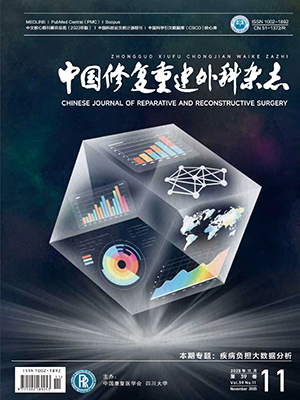Objective Endoplasmic reticulum stress (ERS) mediated apoptosis is one of the eukaryotic cellular
apoptotic pathways, to investigate the potential role of ERS during myocardium apoptosis in rats with severe burn
injury. Methods Sixty-four 7-week-old male Wistar rats, weighing 200-220 g, were randomly divided into 2 groups. Thirty
percentage of total body surface area full-thickness thermal injury was produced in 32 rats of burn group, while sham burn was
produced in 32 rats of control group. The heart tissues were harvested from 8 rats in each group at 1, 4, 7, and 14 days after burn
to observe the changes of myocardium ultrastructure with transmission electron microscope (TEM). Myocardium apoptosis was
detected with TUNEL assay. The expressions of glucose regulated protein 78 (GRP 78), C/EBP-homologous protein (CHOP),
and cleaved Caspase 12 in different pathways of ERS were analysed with Western blot. Results All rats survived during the
experiment. Apoptotic changes of cardiomyocytes were observed in burn group, and the apoptosis index in burn group was
significantly higher than that in control group at each time point (P lt; 0.05), and it reached peak at 7 days after burn injury
(P lt; 0.05). The expressions of myocardial GRP 78, CHOP, and cleaved Caspase 12 showed persistent elevation in burn group.
The expressions of GRP 78 and cleaved Caspase 12 in burn group were significantly higher than those in control group at each
time point (P lt; 0.05), while the expression of CHOP was higher than that in control group at the other time points (P lt; 0.05)
except 1st day after burn injury. Conclusion ERS and CHOP, Caspase 12 mediated apoptotic pathway are activated in
myocardium after severe burn injury, and this may be one pathway of myocardium apoptosis.
Citation: CHU Wanli,CHAI Jiake,FENG Yongqiang,MA Li,HU Chao.. ROLE OF ENDOPLASMIC RETICULUM STRESS DURING MYOCARDIAL APOPTOSIS IN RATS WITH SEVEREBURN INJURY/. Chinese Journal of Reparative and Reconstructive Surgery, 2012, 26(5): 592-596. doi: Copy
Copyright ? the editorial department of Chinese Journal of Reparative and Reconstructive Surgery of West China Medical Publisher. All rights reserved




